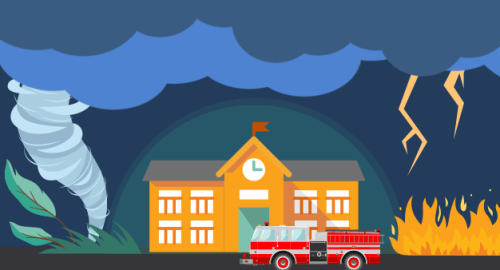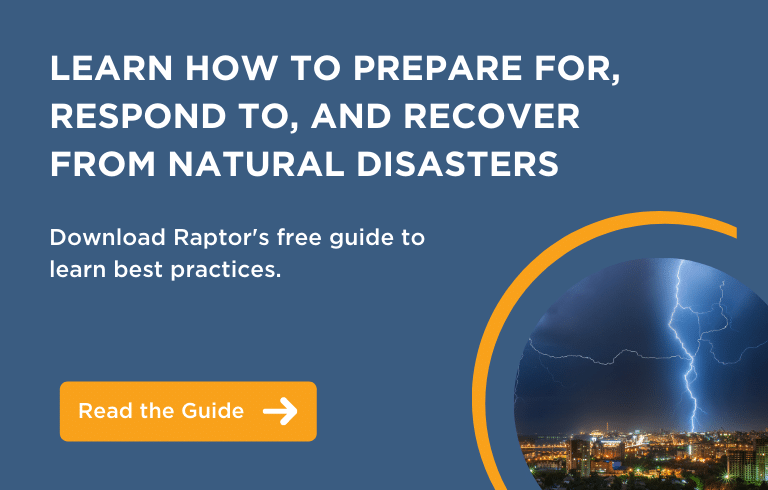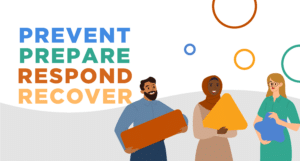Listen to this blog (6 mins)
Raptor recently sat down with three school emergency management experts to discuss lessons learned and how schools can create multi-hazard emergency management plans.
Dr. Leigh Wall, former Santa Fe Texas ISD Superintendent, has led her district through multiple emergencies, including 2017’s Hurricane Harvey and an active mass shooting at Santa Fe High School in 2018.
Dr. CJ Huff, former superintendent for Joplin School District in Missouri, is credited for bringing the entire community together after a devastating tornado struck his district in 2011, killing over 160 people in their city—including a student in his district—and damaging 10 out of the 19 school buildings.
As the former Chief of Police for the 14th largest public school system in our nation (Dallas ISD in Texas), Chief Craig Miller’s expertise in school emergency preparedness and response comes from law enforcement and academic perspectives.
On a recent Raptor webinar, these school emergency management experts shared their perspectives, lessons learned, and valuable insights into K-12 emergency management. A summary of the conversation is below. You can watch the full webinar on-demand here.
What Are Examples of Emergencies Schools Face?
“You have to plan for all kinds of emergencies,” Dr. Wall advised. “Multi-hazard plans are something that you hope you never use, but it sure is important to have in place when things do come up.” And for schools, a lot of incidents can and do come up. Within one school year, Dr. Wall’s district experienced the impacts of a hurricane, a gas leak, and an active shooter tragedy.
Dr. Huff’s district experienced multiple weather-related emergencies, such as a blizzard, earthquake, windstorm, and then a devastating tornado, all within one school year. “In between [all of those], we had a lot of really unique things happen too,” Dr. Huff shared. For example, while the Westboro Baptist Church was protesting across the nation, the church planned to use the same parking lot that the high school students were using for a vigil for the student who tragically lost his life in the tornado.
“The [latter example] is something you typically don’t consider in your emergency operations plans, but that was a significant issue that had to be dealt with because it could have gotten very volatile very quickly.”
How Can Schools Build Emergency Operations Plans for All Hazards?
“It’s complex,” Dr. Wall acknowledged. There are a lot of things to consider around prevention, preparation, and mitigation, and how you will ultimately respond to and recover from any incident. “When you think about a multi-hazard plan, you must plan through each event, [such as natural disasters,] that is very specific to your district, your area, and even down to your particular schools.”
This requires schools to collaborate with internal and external stakeholders. Internal stakeholders are your admins, teachers, safety managers, transportation managers, nurses, counselors, students, guardians, and others. External stakeholders are your local emergency management officers, first responders, police departments, mental health organizations—just to name a few.
Getting everyone involved also helps cultivate relationships, something that becomes very valuable in emergencies. “If you don’t have solid relationships in place and you haven’t built those relationships on the front end, it’s really hard to plan and react with confidence,” Dr. Huff warned.
It’s also important that these relationships are maintained as staff change. “From a school’s perspective, if you have administration that changes over—whether it’s a new superintendent, chief of staff, or principals—they need to go back and reinvent the wheel,” Chief Miller said. “Everyone needs to be on the same page because [the relationships] are invaluable when emergencies happen.”
Should Schools Include Mental Health Support Services in the Emergency Operations Plans?
“Absolutely…It’s probably the most important piece and, unfortunately, the most under-resourced piece” to include in the EOP, Dr. Huff claimed. Emergencies can be incredibly traumatic for everyone involved, especially when lives are uprooted or lost. “This is one commonality that I see across disasters, including the current COVID experience, that…we have to take into account the emotional state of the people that we’re leading. That includes our internal staff as well as our external stakeholders, and the impact that recovery has on everyone.”
Dr. CJ Huff continued, “When emotion and logic collide, emotion wins every single time. We must be cognizant of that as we work through [recovery].”
To hear the rest of the conversation and continue learning directly from Dr. Wall, Dr. Huff, and Chief Miller, make sure to listen to the on-demand webinar.
To learn more about Raptor, contact us today for a personalized demo.






